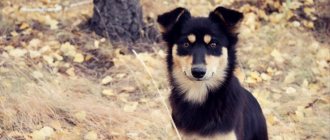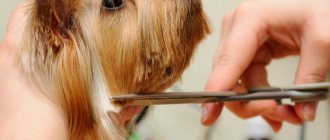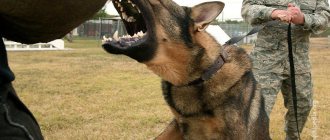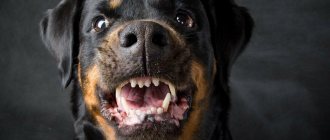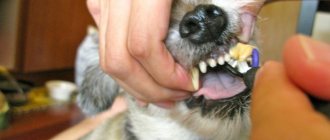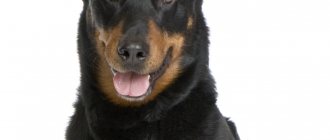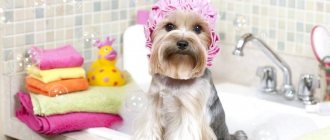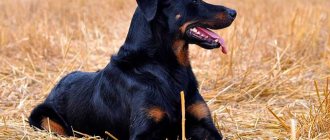Doberman dogs are not only faithful and devoted friends, but also real guards. It is for this reason that they are often started by owners of private houses and country cottages. Caring for these animals is quite simple - the dogs are short-haired, not picky, very flexible and obedient. And docking the ears and tail, as was previously customary, is now not an urgent need. But, you should understand that if your Doberman lives on the street, then he should be provided with everything he needs. It is important to consider all the details and possible risks, both for the animal itself and, for example, for your guests. What is needed for this and how to make the animal’s stay comfortable for itself, we will discuss below.
Characteristics of the Doberman dog breed: advantages and disadvantages
Male:
Bitch:
Price:
Life expectancy: 10–12 years, sometimes up to 16 years. |
| Active walking, proper diet and regular dental examinations are all he needs. There are difficulties with upbringing, which can be overcome by a confident, decisive, but restrained owner. |
| It takes root well both in the house and in the apartment. The main thing is to find something for him to do: he can be a watchman, a companion for children's games. |
| Not suitable for aviaries. He is too attached to his owner and requires constant contact with him. And a short-haired dog cannot sleep in the snow like a husky. If you decide to build an enclosure, then only a warm one. |
| It is enough to carry out water procedures several times a year. |
| Whether or not to crop the ears and tail is the choice of the dog owner. Today the standard allows both options. |
| Even short-haired breeds shed. The wool is cleaned with rubber brushes and wiped with a damp terry towel. Train your pet to use a vacuum cleaner, this will make cleaning easier. |
| The four-legged friend is good with children, but its owner must be an adult. Children from the age of 14 can engage in education. |
| If you do not have experience raising dogs of serious breeds, get a female. They rarely make attempts to gain leadership in the house, they are more flexible and less hot-tempered. |
| The breed is universal - suitable for single people, couples and families with children. |
| The gender of the owner is not as important as his temperament. The Doberman is not suitable for infantile people with an overly soft character. |
| This is an active dog that needs daily exercise. Walking should be active. Let him run freely for at least an hour and at least 10 minutes a day off-leash. |
| In our climate, Dobermans freeze in winter. They need warm blankets for walks in the cold. |
| The pet needs socialization. But with due patience on the part of the owners, he gets along well with his fellow tribesmen and cats. |
Advantages of the breed
- Versatility: can be a guard, a bloodhound, a guide for the blind, a companion.
- With proper training, a dog does not show aggression unless necessary.
- Doberman falls in love with his owner. What the owner requires of him is sacred to him.
- The dog is very observant. If you allow the slightest weakness, he will take advantage of it.
- The behavior of the pet depends on the owner and the methods of education he has chosen.
- This dog has a well-developed search instinct. A four-legged friend can find anything.
- He is smart and smart. Studying and working are the dog’s favorite activities.
- An active and energetic pet will be happy to accompany you while jogging, cycling, and outdoor games.
- The breed is recognized as highly intelligent. Its representatives have a sense of self-esteem and a high degree of responsibility.
- Pets are cunning and have excellent memory. They respond well to training.
- The pet is wayward. This trait manifests itself from an early age. A puppy should be taught discipline as early as possible.
- For busy people, the disadvantage may be the need for constant communication. However, this is fixable, because dogs behave calmer when paired.
- With improper upbringing, a tendency towards aggression may appear.
- Suitable only for strong and strong-willed people; a phlegmatic Doberman may not perceive him as a leader.
- It reacts more painfully than other breeds to a change of owner.
- He perceives new family members with caution. Problems may arise when the baby arrives.
- He loves to sleep and is not averse to choosing the owner’s sofa or bed for this. If you think that such behavior is unacceptable for a four-legged family member, do not allow him to do this and severely punish him for disobedience.
Care
Caring for a Doberman is not difficult:
- There is no need to comb the fur.
- Daily wiping with a wet towel is enough.
- You can bathe once every six months (frequent bathing weakens the immune system).
- Wash your paws after a walk.
- Systematically clean your ears and eyes with a cotton swab dipped in water.
- Watch your teeth and claws.
How to trim claws?
The length of the claws must be monitored. If they themselves do not grind down enough, then they need to be trimmed. This can be done at the veterinarian or at home using special nail clippers. You only need to cut off the keratinized part without touching the body of the claw to avoid injury. If there is blood, then it is enough to attach several crystals of potassium permanganate to the vessel on paper.
It is important to calm the dog so that the procedure does not cause negative associations in the future. It is enough to cut your nails once every 1-2 months.
Dental care
Doberman's teeth are their calling card . They should be closely monitored because they are susceptible, just like humans, to caries and periodontal disease. Inspection and cleaning must be carried out daily. There are dog toothbrushes and toothpastes for these purposes.
List of dog breeds for keeping outside in a kennel
We train the puppy to use the toilet
Despite the fact that the dog will live in a kennel, it is worth taking care of normal conditions. In winter, the temperature can drop quite low, so it is worth insulating the booth.
Booth requirements:
- Removable roof. This is necessary so that you can properly clean the inside of the dog’s house. Then make sure that the joints between the walls and the roof are airtight. This will prevent water from flowing in during rain. The roof should not be straight, but be inclined. This will ensure rapid drainage of water and snow.
- Insulated walls. It could be polystyrene foam. It perfectly retains heat inside the booth and does not heat up much when exposed to sunlight. Some dogs can chew foam, so you can line the inside of the house with a sheet of USB. The dog will be warm and cozy.
- Sufficient size. The size of the booth should be such that the dog inside it can stand up, sit and turn around normally. At the same time, you should not make a huge booth, since in winter the dog will freeze in it.
- Material. It is best to make a booth from plastic or wood. These materials do not heat up and are easy to clean.
- Entrance. It is best to make the entrance not in the middle, but from the side. This will allow the dog to hide from the wind. In this case, the entrance can be covered with a layer of felt. It is secured at the top and hangs over like a curtain. The dog can easily enter the kennel, but it is also warm and cozy in the winter.
- Floor. It must be made of boards. In this case, it is best to place the booth on legs. In this case, it will not contact the ground. There will be an air cushion between the floor and the ground. Do not cover the floor with a cotton blanket. When wet, it takes a long time to dry and can begin to rot. In addition, many dogs deliberately take all the trash outside the booth. The most interesting thing is that almost none of the pets throw hay out of the kennel.
Dog breeds for keeping outside in a kennel: list
Dog breeds for keeping in a kennel:
- German Shepherd
- Rottweiler
- Asian
- Caucasian
- Husky
- Samoyed
- Laika
- Malamute
Dog breeds for keeping outside in a kennel: list
Why don't dogs freeze in the cold in winter?
- Of course, the statement that dogs do not freeze in the cold does not apply to each of the many breeds. A lot depends on what kind of hair the dog has: short or long, hard or soft, how thick the undercoat is.
Cold
- So, the thicker, stiffer and longer the wool, the more frost-resistant the breed is and the lower the critical temperatures it can withstand.
- For example, the wool of Caucasians, Moscow watchdogs or Leonbergers , not to mention Huskies, allows them to easily withstand temperatures down to minus 40.
- Moreover, their coat makes positive temperatures not very comfortable for such dogs. But if a representative of such breeds has been raised since puppyhood and kept in conditions that correspond to the characteristics of its coat, then by winter it will grow additional undercoat that warms it.
- In addition, the breeds listed above are large, which do not freeze much longer, since the process of heat transfer takes place more slowly in them.
- Young and healthy dogs tolerate cold temperatures better ; puppies, old or sick dogs with a depleted body, and especially those with arthritis, freeze much faster.
Not all dogs are cold
- The dog’s diet also affects its “frost resistance” - the more caloric and balanced it is, the longer the animal’s body can retain heat.
Choosing and caring for a puppy
Forbidden symbol allowed sign no dogs Free Photo
You can bring a puppy home no earlier than he is a month old, preferably 45 days. It would be good if during the selection process you have the opportunity to consult with an experienced dog breeder who is familiar with the characteristics and standards of the breed.
When choosing a puppy, they are guided by the following criteria:
- baby's health;
- appearance and grooming;
- no visible health problems;
- activity in behavior.
Sometimes an albino puppy appears in the litter. You can't take it. The fact is that such a baby has serious health problems. Albinos are not healthy.
Breed standards
| Usage | Police, security, protection dog, companion. |
| Appearance | The dog is above average height, strong build, muscular and elegant. |
| Temperament, behavior | Brave and decisive character, lively temperament. |
| Head |
|
| Frame |
|
| Limbs |
|
| Gait | The step is free and sweeping. Running is easy and fast. Ambling is a vice. |
| Wool | The coat is short, shiny with slight undercoat. |
| Color | Black, dark brown with reddish tan marks. |
| Height |
|
| Flaws | Deviation from the above parameters is a disadvantage. |
| Significant disadvantages |
|
What does a growing Doberman need?
Wolfdog of Saarloos
The puppy has grown up, been vaccinated, and it’s time to take him for walks outside. When choosing ammunition, take your dog with you to the store, where you can try it on and choose the best option.
Collar:
- wide enough so as not to put pressure on the dog’s neck;
- multi-layered so that it does not tear at the most inopportune moment;
- with a durable welded ring for attaching the leash.
Muzzle:
- Should allow the dog to open its mouth slightly to breathe. You need to make sure that her nose does not rest against the front wall, but does not slide down, keeping well on the muzzle.
- Good quality plastic muzzles are comfortable. They are durable, hygienic (can be washed after a walk) and do not conduct cold.
Leash:
Take his choice seriously - sometimes the dog’s life depends on it
Pay special attention to the carabiner. It must be made of good metal, not bend or break, fasten securely and fit the collar ring
Be sure to have a swivel that allows the carabiner to spin and gives the dog the opportunity to cut circles around the owner without tangling the leash.
Harness:
- Used for strength and towing training, in guard and search work. It allows you to evenly distribute the load on the chest and body when the dog pulls.
- Requirements: It must fit snugly on the dog, without dangling or constricting the body.
- The harness is not intended for permanent use because it shifts the center of gravity.
Aviary:
Owners of their own estate can build an aviary with an insulated booth on the site. It will come in handy for the Doberman in the summer, in case the dog is unable to get into the house while the owner is away. Here she can wait out the rain or bad weather.
At what temperature does a dog freeze?
This is influenced by many factors. The freezing threshold is related to the general health of the dog - if he is sick, he will freeze even at a temperature that he could previously withstand.
- It is important how thick its coat is and how thick the undercoat is - long-haired animals can easily tolerate 20-25 degree frost. A short-haired dog without special clothing will not withstand such temperatures: its “ceiling” is 5°C.
What does it depend on?
- You should not take your dog outside hungry - in this case, the dog will freeze faster even at his usual temperature. And, of course, the external environment in which the animal grew up is important.
- A dog accustomed to room temperatures may begin to tremble even when the thermometer reaches zero, but one raised in outdoor conditions can easily endure much greater frosts.
- An example is stray dogs living in the northern regions: they, curling up in the holes they dug, endure frosts down to -50°C.
What to feed
The shape of a pet's ears is not the only dilemma that owners of pedigree dogs face. They also have to choose what to feed the Doberman. This can be dry food or natural feeding. You can contact the breeder for help. Look at his dogs. If you are happy with their appearance, you can feed them the same food. However, the choice is yours.
What you definitely shouldn’t do is mix dry food with natural food. Such a diet can harm the digestive system.
Puppy diet
The puppy you just bought should be fed according to the breeder's instructions. He experiences stress when changing his place of residence. During this period, changing your diet can lead to stomach upset.
When using dry food, follow the recommendations on the packaging. When choosing “natural” food, the emphasis is on meat. From 2.5 weeks it is given in scraped form, from 3 months of age it is cut into pieces of 1.25 cm. Raw beef and veal are suitable for babies. At 3 months they give lamb.
Daily meat intake for puppies depending on age:
- 1 month – 50 g;
- 2 months – 100 g;
- 3 months – 300 g;
- 4 months – 400 g;
- 5 months – 500 g.
Trimes, hearts, lungs and chicken stomachs are taken from offal. Porridge, vegetables, cheese, crackers can only be an addition to a meat dish. Puppies are given cottage cheese and fermented milk products. Among the cereals, preference is given to buckwheat, rice, oatmeal, and millet. During the period when the ears are set, puppies are given calcium, which is necessary for the formation of cartilage.
Adult dog diet
Feeding an adult Doberman with natural food is a difficult and expensive task. Dogs are recommended to eat a day:
- meat products or fish – 600–800 g;
- porridge – 500–800 g;
- vegetables – 200 g;
- cottage cheese – up to 300 g;
- fermented milk products – up to 200 g.
This is the minimum necessary for animals. The food should be thick. Soups are not suitable for Dobermans. With significant physical exertion, during active training, the portion of meat is increased to 1200–1400 g. This also applies to pregnant and lactating bitches.
The following foods are not suitable for Dobermans:
- smoked, salted, fatty meat;
- pork and chicken bones;
- sausage, frankfurters, store-bought stews, dumplings;
- food from the owner's table;
- pasta (they are poorly digested and cause fermentation in the stomach);
- fresh pastries, bread in large quantities (but sometimes you can eat crackers);
- peas, corn, raw dough;
- semolina porridge (it provokes obesity and causes “reverse peristalsis” in some dogs);
- potatoes in any form.
Adult dogs are recommended to be fed 2 times a day. Animals do not need a varied menu. They calmly eat the same thing all their lives.
Doberman dog character, behavior
There are many rumors and legends about dogs of this breed. Most of them have no basis. In fact, the Doberman is moderately aggressive and does not like to bite, as is often shown in films. Biting dogs do occur, but this is due to improper selection or errors in education.
Initially, the Doberman is a balanced creature. If it falls into capable hands, it reveals all its best qualities.
And vice versa, the pet will fool a not very smart owner. In such cases, the dog becomes the leader in the family and may show unmotivated aggression.
This breed is not for everyone. It can create inconvenience. A bored Doberman, especially a young one, can damage property in the house, organize concerts with howling and other performances
And all with a single goal - to attract attention. But find something to do for him, and you will see what a wise and strong protector your Doberman will become
The characteristics of the breed confirm this.
Behavior at home
Many owners say that he is able to guess thoughts. And the pet really knows how to amaze. Especially unique abilities to distinguish between good and evil on an intuitive level, as well as speed of reaction to what is happening and boundless devotion. A Doberman playing with children is a familiar sight for owners of the breed.
If there is no mutual understanding in the house, the animal will grow up hot-tempered and unbalanced.
He is sensitive to the microclimate in the house, quickly reacts to quarrels between family members and the mood of the owner. He really doesn't like it if people don't pay attention to him. After all, a handsome, stately man is a social and intellectual being.
Behavior on the street
During a walk, the four-legged friend always keeps the owner in sight. He is ready to come to his aid at the slightest danger. Untrained dogs or individuals with unstable psyches may show aggression towards moving objects. This is not the norm.
Aggression in itself is not a defect. This is a normal quality that a dog needs. It only becomes a problem when it is excessive.
A responsible breeder will exclude such individuals from breeding. And an experienced owner corrects it with education.
Attitude towards strangers, protection of the owner and home
The Doberman is a dog for protection, not for attack. If you socialize your puppy from an early age, accustoming him to the presence of strangers and animals nearby, the pet will calmly react to them in adulthood.
But a hot temper can manifest itself when meeting with fellow tribesmen: the dog sometimes gets involved in fights, in which, as a rule, he wins. He will not wag his tail at the sight of his owner's friends. Usually the pet is indifferent and cold towards everyone except members of the owner's family.
Training and education
A Doberman puppy resembles pliable plasticine. Thanks to his natural ingenuity and athletic build, he is easily trained and can master any service.
In urban conditions, the puppy must learn the following commands:
- "to me";
- "stand";
- "near";
- "ugh".
The puppy must know what he can do in the house and what he cannot do. Misdeeds are punished. Babies have short memories. Punishment must follow immediately after the offense. Adult dogs remember much longer. They can be punished after some time. But between the punishment and the offense there should be no feeding or walking.
If possible, you need to train your Doberman in a dog training area. There, experts will suggest important points and point out mistakes in upbringing.
Smart Dobermans learn basic commands faster than other breeds. Training must be provided by the owner. To gain authority, you need to ensure that commands are followed. Otherwise, the cunning Doberman will begin to come up with tricks.
Diseases of Dobermans
A puppy adopted from parents you know and raised correctly will not cause problems with its health if you carefully monitor it and do not show negligence. Be especially attentive to your pet's heart function and the condition of its joints. Seek advice from trusted veterinarians and your dog will live a long, happy life.
A beautiful and well-groomed dog - these are the first associations that arise when you see a Doberman. This is a serious breed, so it requires careful care and competent education.
The Doberman is one of the most suitable breeds for protection, sports, detection work and games. Dogs are distinguished by such qualities as:
- energetic temperament - they do not sit still, they are constantly in search of adventure;
- vigilance – with such a security guard you don’t have to worry about safety;
- obedience and hard work - working with him will bring a lot of pleasure;
- inexhaustible enthusiasm - you will have to make a lot of effort to direct their energy in the right direction;
- the ability to protect their territory and members of the “pack” - while they can be dangerous to others;
- intelligence – the intellectual abilities of representatives of the breed are at a high level;
- absence of diseases typical for service breeds - the breed has maintained good health and has an exterior that has not been disfigured by humans.
Dobermans belong to the golden fund of the best guard breeds in the world. However, heredity plays a large role in the character of an animal. Proper upbringing can do a lot, but not everything. A genetically deformed psyche cannot be corrected. If you decide to get a purebred pet, choose a breeder responsibly.
Cupping
On this occasion, more than one spear has been broken in modern dog breeding.
If you are attracted to the image of a Doberman with cropped ears and tail, then it is worth remembering that this operation must be performed before the puppy is 12 weeks old. At a later date, it will be more difficult for his body to cope with the load of healing surgical sutures.
It is definitely better to entrust this work to a veterinarian. In a good clinic, the puppy will be given safe anesthesia, clamps will be placed on the ears to form the future shape of the ear, trimmed to fit the size of the head, and stitches will be placed correctly. A good surgeon acts as a sculptor in this operation.
Then you will have to go through the installation of the ears - attaching the operated ears to a special frame using an adhesive plaster.
Be sure to consult with the breeder about how to do this correctly so as not to spoil the surgeon’s work, and most importantly, the dog’s appearance.
In many European countries, starting with the homeland of these dogs - Germany, a legal ban on docking has been introduced. Dobermans with uncropped ears and tails are full-fledged representatives of their breed.
Origin story
In the 80s of the 19th century, tax collector Friedrich Louis Dobermann set out to breed the ideal dog that would accompany him on his trips. And since the taxman maintained a shelter for dogs of different breeds, the task was quite doable.
As a source material, Doberman took a German pinscher and added to it the blood of a Rottweiler, Manchester terrier, and possibly pointers. There are no exact data on breeding work. The talented dog breeder kept no records. But the results of his work are unique.
Dobermans were the best police dogs of the early last century. Newspapers of that time vied with each other to talk about the exploits of tall and stately pinschers.
Louis Doberman died in 1884 without ever learning about the recognition of the breed, which did not happen until 1895. Since that time, the dog has changed several names: Tring Pinscher, Doberman Pinscher, and only since 1949 it has been called Doberman. History knows no other cases when a German breed was named after its creator.
Ear and tail docking: what you need to know about it
In our country, docking is not prohibited. But many countries abandoned this operation. Dogs with cropped ears and tails cannot take part in exhibitions in these countries. However, many are more accustomed to seeing the Doberman with a short tail, with ears on the top of its head.
At local shows you can see dogs with floppy and high-protruding ears, with and without tails. Today, undocked ears are recognized as equivalent to cropped ears. But in the homeland of the breed, in Germany, Dobermans’ ears are no longer cropped. In this case, the choice remains with the owners and the breeder. Only you can decide what your Doberman will be like. Ear cropping is a cosmetic procedure. We carry it out in veterinary clinics.
For Dobermans, the operation is combined with ear placement. The procedure is recommended to be carried out at 3 months of age, usually after the 2nd vaccination. The operation is performed under anesthesia.
When cut, the length of the ear should be at least 3/5 of its original length. To do this, use special patterns and clamps to fix them. After cutting off part of the auricle, a cotton-gauze pad is placed on the back of the head. The ears are placed in it in a straightened form. Strengthen everything with a bandage. After 3-4 hours, the bandage is removed.
Then a special “crown” is constructed. The dog wears it until the ears heal. The structure is made of wire. His goal is to put ears on. The ears are fixed using an adhesive plaster and bandage.
